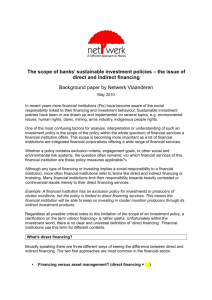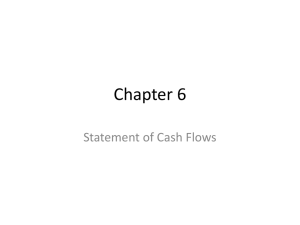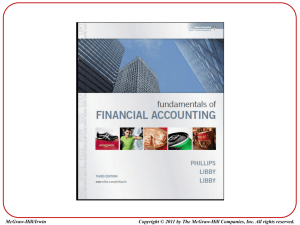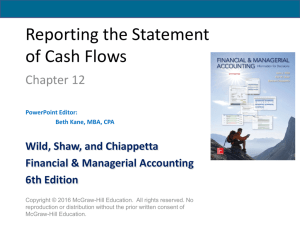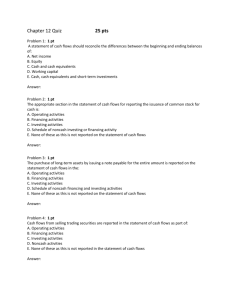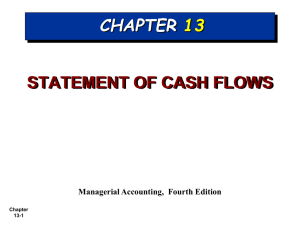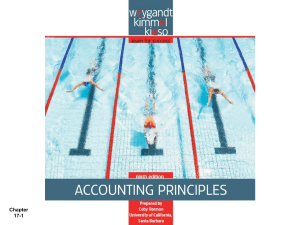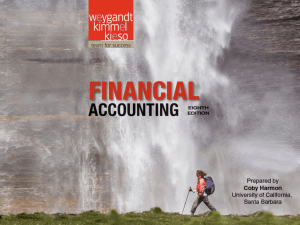Chp 12 Slides 12_Ch_12_Slides
advertisement
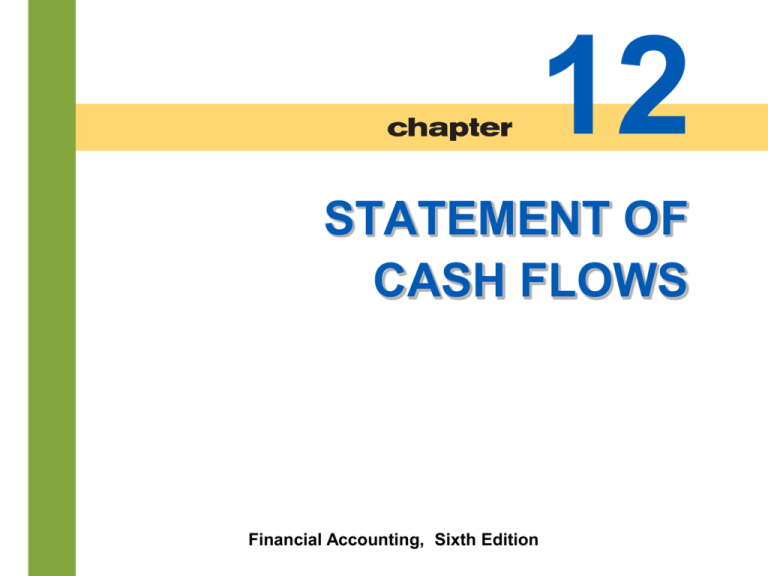
12 STATEMENT OF CASH FLOWS 12-1 Financial Accounting, Sixth Edition Study Objectives 12-2 1. Indicate the usefulness of the statement of cash flows. 2. Distinguish among operating, investing, and financing activities. 3. Explain the impact of the product life cycle on a company’s cash flows. 4. Prepare a statement of cash flows using the indirect method. 5. Use the statement of cash flows to evaluate a company. Usefulness and Format Usefulness of the Statement of Cash Flows Provides information to help assess: 1. Entity’s ability to generate future cash flows. 2. Entity’s ability to pay dividends and obligations. 3. Reasons for difference between net income and net cash provided (used) by operating activities. 4. Cash investing and financing transactions during the period. 12-3 SO 1 Indicate the usefulness of the statement of cash flows. Usefulness and Format Classification of Cash Flows Operating Investing Financing Activities Activities Activities Income Changes in Investments and Long-Term Asset Items Changes in Long-Term Liabilities and Stockholders’ Equity Statement Items 12-4 SO 2 Distinguish among operating, investing, and financing activities. Usefulness and Format Classification of Cash Flows 12-5 Illustration 12-1 Typical receipt and payment classifications SO 2 Distinguish among operating, investing, and financing activities. Usefulness and Format Classification of Cash Flows 12-6 Illustration 12-1 Typical receipt and payment classifications SO 2 Distinguish among operating, investing, and financing activities. Usefulness and Format Significant Noncash Activities 1. Issuance of common stock to purchase assets. 2. Conversion of bonds into common stock. 3. Issuance of debt to purchase assets. 4. Exchanges of plant assets. Companies report noncash activities in either a 12-7 separate schedule (bottom of the statement) or separate note to the financial statements. SO 2 Distinguish among operating, investing, and financing activities. Usefulness and Format Format of the Statement of Cash Flows Order of Presentation: 1. 12-8 Operating activities. 2. Investing activities. 3. Financing activities. Direct Method Indirect Method SO 2 Distinguish among operating, investing, and financing activities. Format of the Statement of Cash Flows Illustration 12-2 12-9 SO 2 Distinguish among operating, investing, and financing activities. Format of the Statement of Cash Flows Illustration: Classify each of these transactions by type of cash flow activity. 12-10 1. Issued 100,000 shares of $5 par value common stock for $800,000 cash. Financing 2. Borrowed $200,000, signing a 5-year note bearing 8% interest. Financing 3. Purchased two semi-trailer trucks for $170,000 cash. Investing 4. Paid employees $12,000 for salaries and wages. Operating 5. Collected $20,000 cash for services provided. Operating SO 2 Distinguish among operating, investing, and financing activities. Usefulness and Format The Corporate Life Cycle Illustration 12-3 Impact of product life cycle on cash flows. 12-11 SO 3 Explain the impact of the product life cycle on a company’s cash flows. Usefulness and Format Preparing the Statement of Cash Flows Three Sources of Information: 1. Comparative balance sheets 2. Current income statement 3. Additional information 12-12 SO 3 Explain the impact of the product life cycle on a company’s cash flows. Preparing the Statement of Cash Flows 1. 2. 3. 4. Prepare a skeleton of the statement Compute target figure Enter Net Income into statement Analyze each non-cash account on B/S 12-13 We will use only the indirect (easiest) method in this course. Preparation of the Statement of Cash Flows – Indirect Method Step 1: Operating Activities Determine net cash provided/used by operating activities by converting net income from accrual basis to cash basis. Common adjustments to Net Income (Loss): 12-14 Add back non-cash expenses (depreciation, amortization, or depletion expense). Deduct gains and add losses. Changes in noncash current assets and current liabilities. SO 4 Prepare a statement of cash flows using the indirect method. Step 1: Operating Activities Depreciation Expense Although depreciation expense reduces net income, it does not reduce cash. The company must add it back to net income. Illustration 12-7 Cash flows from operating activities: Net income $ 145,000 Adjustments to reconcile net income to net cash provided by operating activities: Depreciation expense Net cash provided by operating activities 12-15 9,000 $ 154,000 SO 4 Prepare a statement of cash flows using the indirect method. Operating Activities Loss on Sale of Equipment Companies report as a source of cash in the investing activities section the actual amount of cash received from the sale. Any loss on sale is added to net income in the operating section. Any gain on sale is deducted from net income in the operating section. 12-16 SO 4 Prepare a statement of cash flows using the indirect method. Operating Activities Loss on Sale of Equipment Illustration 12-8 Cash flows from operating activities: Net income $ 145,000 Adjustments to reconcile net income to net cash provided by operating activities: Depreciation expense 9,000 Loss on sale of equipment 3,000 Net cash provided by operating activities 12-17 $ 157,000 SO 4 Prepare a statement of cash flows using the indirect method. Operating Activities Changes to Noncash Current Asset Accounts When the Accounts Receivable balance decreases, cash receipts are higher than revenue earned under the accrual basis. Illustration 12-9 Accounts Receivable 1/1/012 Balance Revenues 12/31/12 Balance 30,000 507,000 Receipts from customers 517,000 20,000 Company adds to net income the amount of the decrease in accounts receivable. 12-18 SO 4 Prepare a statement of cash flows using the indirect method. Operating Activities Changes to Noncash Current Asset Accounts When the Inventory balance increases, the cost of merchandise purchased exceeds the cost of goods sold. Inventory 1/1/12 Balance Purchases 12/31/12 Balance 10,000 155,000 Cost of goods sold 150,000 15,000 Cost of goods sold does not reflect cash payments made for merchandise. The company deducts from net income this inventory increase. 12-19 SO 4 Prepare a statement of cash flows using the indirect method. Operating Activities Changes to Noncash Current Asset Accounts When the Prepaid Expense balance increases, cash paid for expenses is higher than expenses reported on an accrual basis. The company deducts the decrease from net income to arrive at net cash provided by operating activities. If prepaid expenses decrease, reported expenses are higher than the expenses paid. 12-20 SO 4 Prepare a statement of cash flows using the indirect method. Operating Activities Changes to Noncash Current Liability Accounts When Accounts Payable increases, the company received more in goods than it actually paid for. The increase is added to net income to determine net cash provided by operating activities. When Income Tax Payable decreases, the income tax expense reported on the income statement was less than the amount of taxes paid during the period. The decrease is subtracted from net income to determine net cash provided by operating activities. 12-21 SO 4 Prepare a statement of cash flows using the indirect method. Operating Activities Summary of Conversion to Net Cash Provided by Operating Activities— Indirect Method 12-22 Illustration 12-12 SO 4 Prepare a statement of cash flows using the indirect method. Step 3: Net Change in Cash Compare the net change in cash on the Statement of Cash Flows with the change in the cash account reported on the Balance Sheet to make sure the amounts agree. 12-23 SO 4 Prepare a statement of cash flows using the indirect method. Using Cash Flows to Evaluate a Company Free Cash Flow Illustration 12-15 Free cash flow describes the cash remaining from operations after adjustment for capital expenditures and dividends. 12-24 SO 5 Use the statement of cash flows to evaluate a company. Using Cash Flows to Evaluate a Company Illustration 12-16 Illustration Required: Calculate Microsoft’s free cash flow. Cash provided by operating activities Less: Expenditures on property, plant, and equipment Dividends paid Free cash flow 12-25 $19,037 3,119 4,468 $11,450 SO 5 Use the statement of cash flows to evaluate a company. Using Cash Flows to Evaluate a Company Assessing Liquidity and Solvency Liquidity is the ability to pay obligations expected to become due within the next year. Illustration 12-18 A value below .40 times is cause for additional investigation. 12-26 SO 5 Use the statement of cash flows to evaluate a company. Using Cash Flows to Evaluate a Company Assessing Liquidity and Solvency Solvency is the ability of a company to survive over the long term. Illustration 12-19 A ratio below .20 times is cause for additional investigation. 12-27 SO 5 Use the statement of cash flows to evaluate a company.

